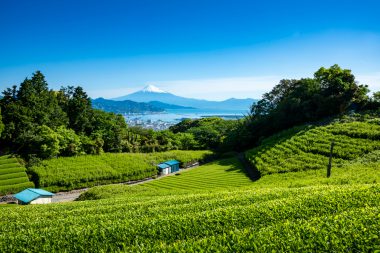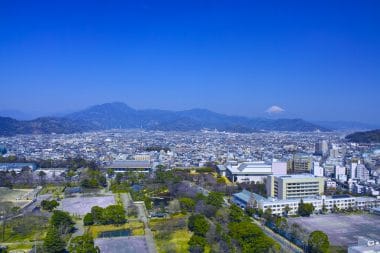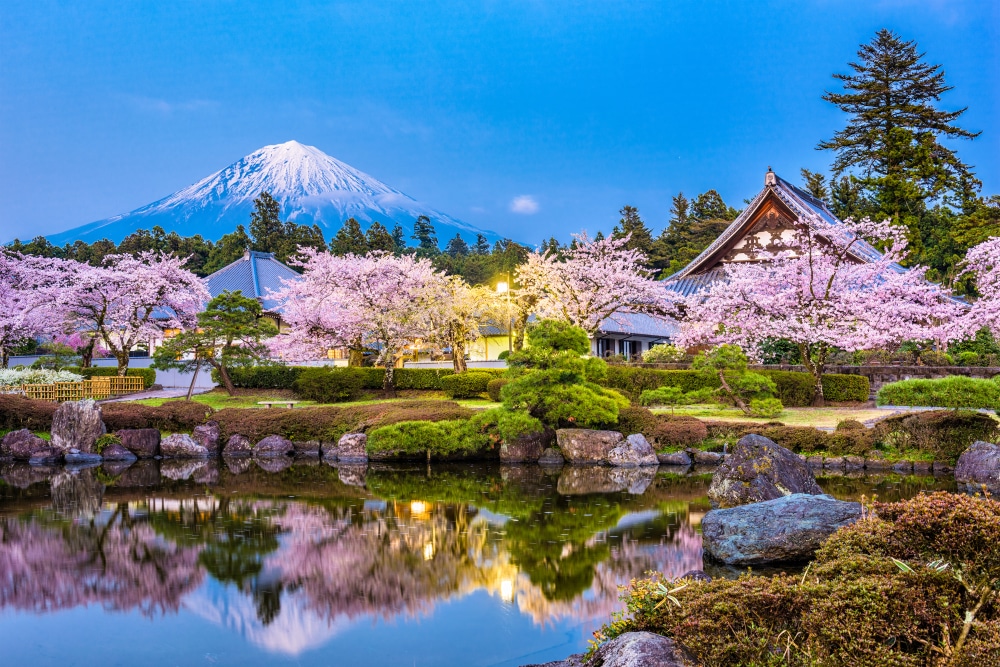With just under 700,000 inhabitants, Shizuoka is not exactly the largest city in Japan, but one of the most beautiful and interesting, which is also embedded in a dreamlike natural landscape. The city is located on the south coast of Japan’s main island of Honshū, right on the coast of the Pacific Ocean: right in the middle between the metropolises of Tokyo and Nagoya. City dwellers appreciate Shizuoka as a local recreation area, and not without reason. Shizuoka is surrounded by enchanting mountains, such as Mount Fuji, which is considered the symbol of Japan with its always white peaks. In addition, the region is very green and surrounded by dense forests. The plantations around the city grow the best green tea in the country, and the Pacific Ocean is home to beautiful beaches.
Mount Fuji as a place of pilgrimage

Basically, Mount Fuji, which rises 3,776 meters into the air, is not a mountain at all, but a volcano. This explains its cone-like shape. It is embedded in a fabulously beautiful mountain landscape. Around Mount Fuji is another remarkable peak, the 2,693-meter-high Hoeizan. In addition, there are several caves and five idyllic lakes at the foot of Mount Fuji, which has been a UNESCO World Heritage Site since 2003. The outdoor opportunities around Mount Fuji are almost sprawling. Four routes of different lengths lead mountaineers up to the summit. Due to its shape, Mount Fuji is easy to master even for less experienced mountaineers. If you are not quite so ambitious, choose one of the flatter hiking routes, from which you also have wonderful views of the surrounding area. On the way through the wooded area, you pass stalactite caves and hot mineral springs. In the past, climbing Mount Fuji was part of the training of young Buddhist monks. The Buddhists consider the mountain to be sacred. Because of this, Mount Fuji is now a kind of pilgrimage site. Pilgrims venerate the shrines found at the foot of the mountain, which emphasize the spiritual significance of the pilgrimage site.
Traditional Japanese: the city of Shizuoka
Shizuoka is bursting with tradition. It is the center of the Japanese tea trade. There are teahouses on every corner of the city, where you can experience a traditional Japanese tea ceremony. In addition, classic Japanese lacquerware, bamboo and wicker are produced in Shizuoka, which often come in the form of art objects and small furniture. Worth seeing is Sumpu Castle, which dates back to 1589 and is located on the outskirts of the city. A shogun used to live here. The castle is surrounded by a park. During a walk across the grounds, you stroll past individual buildings built in traditional style. The model of a mini Fuji can be seen in the park. Next to it is a mini tea plantation. Those who come here in spring can experience the cherry blossoms in the park, on the first weekend of April, on the occasion of the Shizuoka Festival, even with performances of cherry blossom dances. To the west of Sunpu Park are several shrines dedicated to Japanese deities, which are therefore well worth seeing for their traditional Japanese architecture: Kambe Shrine, Sengen Shrine and Ohtoshimioya Shrine. The Shizuoka Museum of Cultural Heritage displays exhibits from the times of the Tokugawa dynasty, which once lived here, such as weapons, armor, clothing, and everyday objects.
Fabulous views from the Nihondaira Plateau
The Nihondaira Plateau is a hilly green area located directly on the Pacific Ocean, in the urban area of Shizuoka. From here you have wonderful views over the Pacific Ocean and also to Fuji to the east. Inland, the sprawling tea and flower plantations can be overlooked. On a clear day, you can also see the Izu Peninsula, which is considered a surfer’s paradise and is known for its white beaches. If you climb the Nihondaira Plateau at night, you also have a wonderful view of the typically Japanese-illuminated, and bustling Shizuoka. Several hiking trails crisscross the plateau. The cable car takes you up to the Kunozan Toshogu Shrine. The Shizuoka Prefectural Museum of Art, located at the foothills of the plateau, brings together many works of Western and Eastern landscape art. Japanese artists such as Taikan Yokoyama and Jakuchu Ito are represented here, as well as Auguste Rodin, and Claude Monet.
Okuoi National Park

In the hinterland of the city of Shizuoka is the Okuoi National Park. The park is natural, and the Japanese nature conservation authorities want it to stay that way. Ikawa and Hatanagi Lakes can be reached via hiking trails that lead through jungles and rugged mountain landscapes. If you hike to the Okoois Gorge here, you will pass the suspension bridge of the Sumata Valley, one of the main attractions of the national park. The bridge is 90 meters long, and is located at a height of eight meters, above the turquoise shimmering Sumata Reservoir. According to Japanese legend, anyone who reaches the middle of the bridge has one wish, which may go in the romantic direction. Supposedly, such wishes come true. At Lake Sesso, water sports enthusiasts get their money’s worth. Kayaks can be rented here. Alone, or on a guided tour, you can set off to admire the surrounding natural beauties from the water. Okuoi National Park is also known for its hot springs. There are several inns that also offer thermal spring bathing in their rooms. Some springs are open to the public in the wild. Finally, ice rink fans can also look forward to a very special adventure. The steam locomotive takes you from Kanaya station to Senzu. The route leads through wooded areas, and includes several bridges that span mountain lakes and reservoirs. You even think you’re floating above the Nagashima reservoir.


